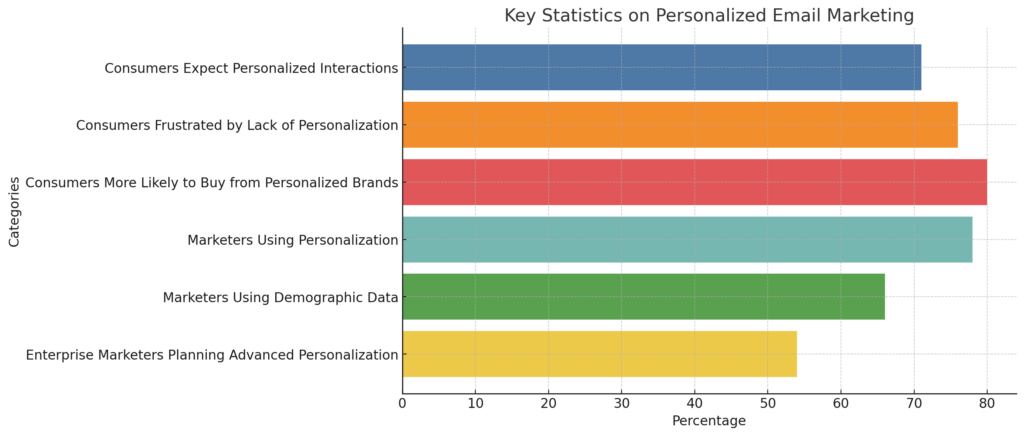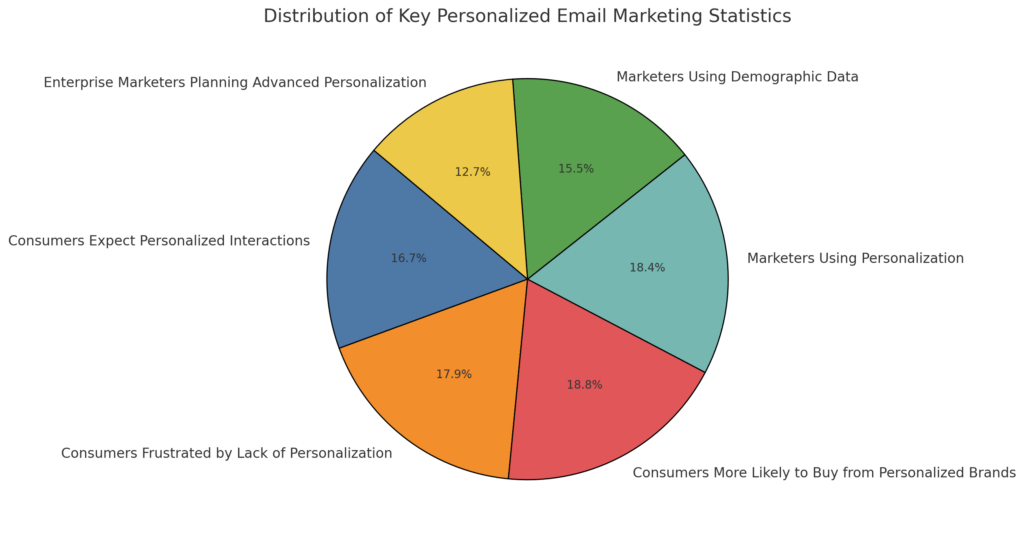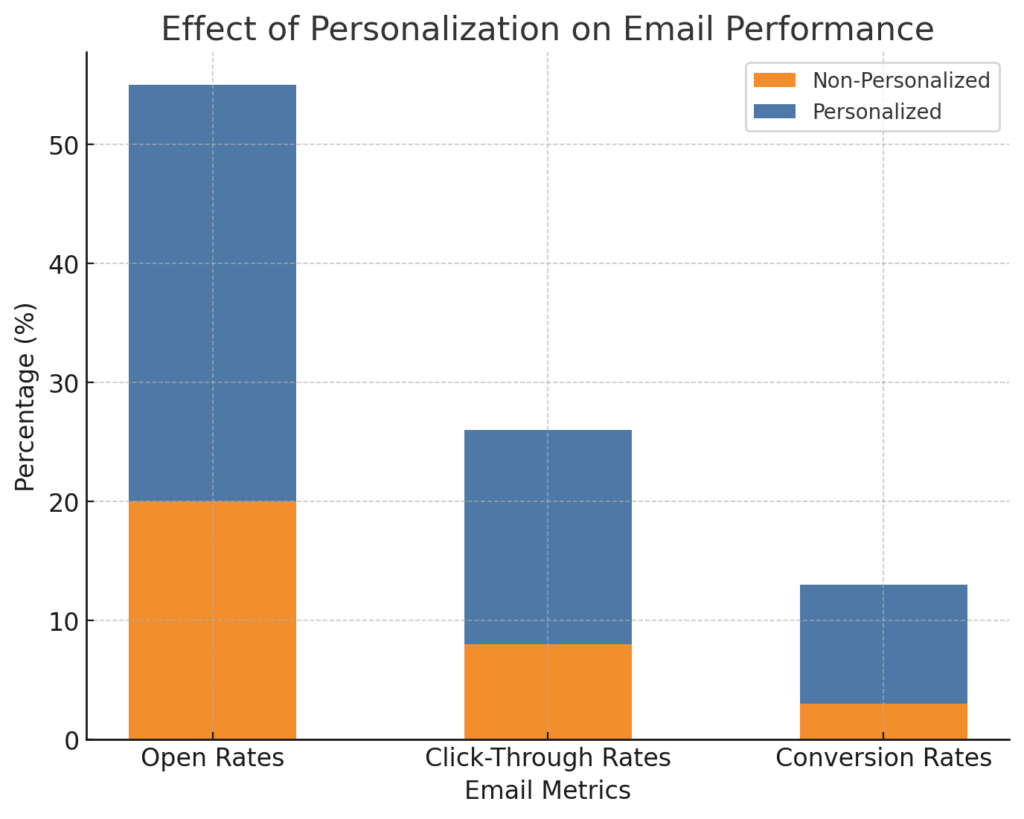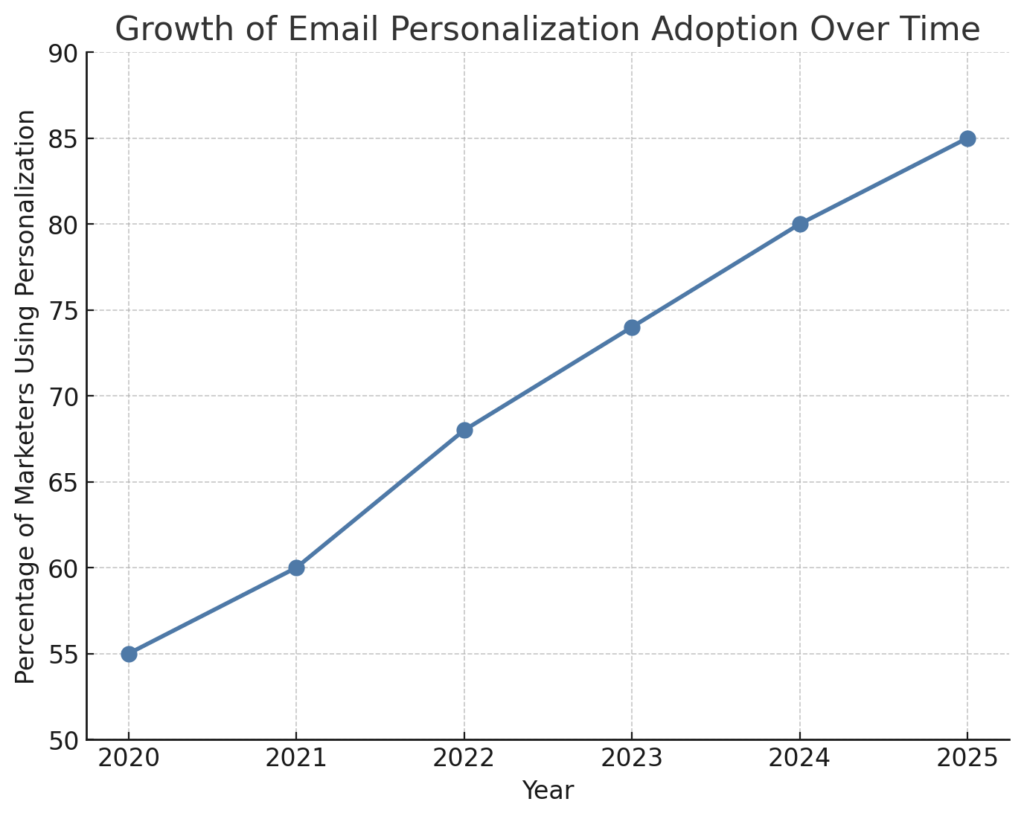
23 Mar PERSONALIZED EMAIL MARKETING STATISTICS 2025
Personalized email marketing has transformed how businesses engage with customers, making messages more relevant, effective, and profitable. As consumer expectations continue to rise, companies must move beyond generic email blasts and embrace data-driven strategies to capture attention and drive conversions. With advancements in AI, automation, and behavioral analytics, brands can now tailor content to individual preferences, boosting engagement and revenue. However, as personalization becomes the standard, businesses face the challenge of balancing customization with privacy concerns. Amra and Elma aims to understand the latest statistics on email personalization to provide valuable insights into what works and where the industry is heading. The following analysis explores key data points, revealing the growing importance of personalization and its future implications. Companies that invest in refining their email marketing strategies today will be best positioned to thrive in an increasingly competitive digital landscape.
PERSONALIZED EMAIL MARKETING STATISTICS 2025 (Editor’s Choice)
Personalized email marketing has become an essential strategy for businesses aiming to enhance customer engagement and drive revenue. Here are 20 key statistics highlighting the impact and trends of personalized email marketing over time and projected into 2025:
1. High Engagement with Personalized Messaging: 72% of consumers engage exclusively with personalized messaging.
2. Increased Open and Click-Through Rates: Personalized emails achieve a 29% higher open rate and a 41% higher click-through rate compared to non-personalized emails.
3. Preference for Promotional Emails: 49% of consumers prefer receiving promotional emails from their favorite brands on a weekly basis.
4. Impact on Repeat Purchases: 60% of consumers are more likely to make repeat purchases after a personalized shopping experience.
5. Consumer Frustration with Irrelevant Emails: 70% of millennials feel frustrated when they receive irrelevant emails from brands.
6. Boost in Visitor Engagement: 57% of marketers have observed improved visitor engagement through email personalization.
7. Expectation for Personalized Experiences: 71% of customers expect personalized experiences, and 76% express frustration when they don’t receive them.
8. Loss of Loyalty Due to Lack of Personalization: 62% of consumers say brands lose their loyalty if they provide unpersonalized experiences.
9. Revenue Generation from Segmented Campaigns: Segmented and targeted emails generate 58% of all revenue, and marketers have noted a 760% increase in revenue from segmented campaigns.
10. Increased Sales Through Personalization: Marketers see an average increase of 20% in sales when using personalized experiences.
11. Higher Transaction Rates: Personalized emails deliver six times higher transaction rates than non-personalized emails.
12. Enhanced ROI: Personalized email marketing generates a median ROI of 122%.
13. Improved Open Rates with Subject Line Personalization: 65% of marketing professionals have sent out campaigns with personalized subject lines, leading to improved open rates.
14. Use of Demographic Data for Personalization: 66% of marketers use demographic data such as gender and age to personalize their emails.
15. Plans to Enhance Personalization Beyond Basic Details: 54% of enterprise marketing professionals plan to personalize emails beyond the first and last name.
16. Consumer Willingness to Share Data: 48% of consumers are willing to exchange their data for better brand experiences.
17. Preference for Personalized Product Recommendations: 56% of online customers are more likely to return to websites offering personalized product recommendations.
18. Impact of AI on Personalization: 36% of marketing professionals plan to leverage AI to craft personalized newsletters.
19. Projected Growth in Email Users: The number of email users worldwide is projected to reach 4.6 billion by 2025.
20. High ROI of Email Marketing: For every $1 spent on email marketing, marketers make $42, highlighting its cost-effectiveness.
These statistics underscore the critical role of personalization in email marketing, emphasizing its effectiveness in enhancing customer engagement, loyalty, and revenue generation.

PERSONALIZED EMAIL MARKETING STATISTICS 2025 and Future Implications
PERSONALIZED EMAIL MARKETING STATISTICS 2025 #1. Personalized emails can produce six times more transactions than non-personalized emails.
This statistic underscores the significant impact of personalization on consumer purchasing behavior. By tailoring email content to individual preferences and behaviors, businesses can create more compelling calls to action, leading to increased conversion rates. As consumers become more accustomed to personalized experiences, generic emails may increasingly be ignored, highlighting the necessity for businesses to adopt personalization strategies. In the future, companies that invest in advanced data analytics and customer segmentation will likely see higher engagement and sales. Moreover, the integration of artificial intelligence (AI) to analyze customer data can further enhance personalization efforts, making marketing campaigns more effective. Businesses should also be mindful of privacy concerns and ensure transparent data practices to maintain customer trust. Overall, the emphasis on personalized email marketing is expected to grow, becoming a standard practice for businesses aiming to optimize their digital marketing efforts.
PERSONALIZED EMAIL MARKETING STATISTICS 2025 #2. 71% of consumers expect companies to deliver personalized interactions, and 76% get frustrated when this doesn’t happen.
This statistic highlights the growing consumer demand for personalized experiences. As digital interactions become more prevalent, consumers anticipate that companies will recognize their individual preferences and tailor communications accordingly. Failure to meet these expectations can lead to frustration, potentially driving customers to competitors who offer more personalized interactions. In the future, businesses that prioritize personalization in their marketing strategies are likely to see increased customer satisfaction and loyalty. This trend suggests that companies should invest in technologies and processes that enable them to understand and respond to individual customer needs effectively. Additionally, training staff to utilize personalization tools and interpret data insights will be crucial. As personalization becomes a standard expectation, businesses that lag in this area risk losing market share to more agile competitors.
PERSONALIZED EMAIL MARKETING STATISTICS 2025 #3. Personalized subject lines increase email open rates by 26%.
The effectiveness of personalized subject lines in boosting open rates emphasizes the importance of customization in email marketing. By addressing recipients directly or referencing their specific interests, businesses can capture attention in crowded inboxes. This approach not only increases the likelihood of emails being opened but also sets the stage for higher engagement with the content. In the future, as inboxes become more saturated, personalized subject lines will be essential for standing out. Companies should leverage customer data to craft subject lines that resonate with individual recipients, thereby enhancing the overall effectiveness of email campaigns. Moreover, continuous testing and optimization of subject lines will be necessary to adapt to changing consumer preferences and behaviors. Investing in AI-driven tools that can automate and refine this process will provide a competitive edge.
PERSONALIZED EMAIL MARKETING STATISTICS 2025 #4. Segmented campaigns can boost revenue by up to 760%.
This statistic illustrates the profound impact of audience segmentation on revenue generation. By dividing their audience into distinct groups based on demographics, behaviors, or preferences, businesses can deliver more relevant content, leading to higher engagement and conversion rates. In the future, advanced segmentation strategies will become increasingly sophisticated, utilizing AI and machine learning to analyze complex data sets and identify nuanced customer segments. Companies that adopt these technologies will be better positioned to deliver personalized experiences at scale, resulting in significant revenue growth. Additionally, dynamic segmentation, where customer groups are continually updated based on real-time data, will allow for more agile and responsive marketing strategies. However, businesses must also ensure compliance with data privacy regulations and maintain ethical data usage practices to sustain customer trust.
PERSONALIZED EMAIL MARKETING STATISTICS 2025 #5. 80% of customers are more likely to purchase from brands that offer personalized experiences.
The strong consumer preference for personalized experiences indicates that customization is a key driver of purchasing decisions. When brands tailor their offerings to individual needs and preferences, customers feel valued, increasing their likelihood of making a purchase. In the future, businesses that excel in delivering personalized experiences will have a competitive advantage in attracting and retaining customers. This trend suggests that companies should invest in technologies and strategies that enable deep personalization, such as AI-driven product recommendations and personalized content. Furthermore, integrating personalization across all customer touchpoints, including websites, emails, and in-store interactions, will create a seamless and cohesive customer journey. As consumers continue to expect higher levels of personalization, businesses that fail to adapt may struggle to maintain market share.

PERSONALIZED EMAIL MARKETING STATISTICS 2025 #6. Personalized emails are opened 82% more than generic emails.
The substantial increase in open rates for personalized emails highlights the effectiveness of customization in capturing recipient attention. By tailoring email content to individual preferences and behaviors, businesses can significantly enhance engagement. In the future, as consumers become more discerning about the communications they receive, personalized emails will be crucial for maintaining high open rates. Companies should leverage data analytics to understand customer preferences and craft emails that resonate on a personal level. Additionally, the use of dynamic content that adapts to individual recipient data will further enhance personalization efforts. As email marketing continues to evolve, businesses that prioritize personalization will be better equipped to navigate changing consumer expectations and technological advancements.
PERSONALIZED EMAIL MARKETING STATISTICS 2025 #7. 52% of consumers say they’ll go somewhere else to find what they’re looking for if an email is not personalized.
This statistic underscores the potential negative impact of generic email communications. When emails lack personalization, over half of consumers are willing to seek alternatives, indicating that irrelevant content can drive customers away. In the future, businesses must recognize that personalization is not just a competitive advantage but a necessity for customer retention. With increasing options available to consumers, brands that fail to personalize their messaging risk losing their audience to competitors who provide a more tailored experience. To prevent this, companies should invest in behavioral tracking and AI-driven automation tools to deliver content that aligns with individual interests. Additionally, incorporating interactive elements such as personalized product recommendations or dynamic pricing can enhance the effectiveness of email campaigns. As consumer expectations continue to evolve, businesses that do not prioritize personalization may struggle to maintain engagement and loyalty.
PERSONALIZED EMAIL MARKETING STATISTICS 2025 #8. 64% of marketers believe that email personalization is the most effective digital marketing tactic.
This statistic highlights the strong consensus among marketers regarding the power of personalization in email campaigns. As consumer engagement becomes increasingly difficult due to the vast number of digital touchpoints, personalized emails offer a way to cut through the noise. In the future, the reliance on email personalization will only grow, with more sophisticated AI and machine learning tools enabling hyper-targeted messaging. Marketers who invest in data-driven personalization strategies will see higher returns, as consumers are more likely to engage with content that feels tailored to their interests. The challenge will be balancing personalization with data privacy concerns, ensuring that consumers feel comfortable sharing their information. Additionally, businesses will need to continuously test and refine their personalization efforts to keep up with changing preferences. Those who fail to adapt to this trend risk falling behind as competitors double down on advanced personalization techniques.
PERSONALIZED EMAIL MARKETING STATISTICS 2025 #9. Dynamic content in emails can increase engagement rates by up to 73%.
The use of dynamic content—such as real-time product recommendations, location-based offers, or interactive elements—demonstrates the power of real-time personalization in email marketing. By tailoring email content dynamically based on user behavior or preferences, businesses can significantly improve engagement rates. In the future, brands that leverage AI and automation to personalize email content at scale will see the most success. Advances in predictive analytics will allow marketers to anticipate customer needs and serve relevant content before the consumer even realizes they want it. However, maintaining authenticity in dynamic content will be key, as overly automated messages may feel impersonal. Marketers must strike a balance between automation and a human touch to keep customers engaged. As AI-driven personalization becomes more common, consumers may come to expect a fully customized experience in all brand interactions.
PERSONALIZED EMAIL MARKETING STATISTICS 2025 #10. Personalized email campaigns can generate six times higher revenue than non-personalized campaigns.
This statistic solidifies the direct correlation between personalized email marketing and increased revenue. By delivering targeted offers, personalized recommendations, and individualized messaging, brands can encourage higher spending from customers. In the future, businesses that do not integrate personalization into their email strategies will struggle to compete, as generic campaigns yield lower returns. AI-powered predictive analytics will become more common, allowing brands to analyze past purchasing behavior and predict future buying patterns with precision. Additionally, the integration of email with other digital marketing channels—such as social media retargeting and personalized website experiences—will further enhance its effectiveness. Companies must also be mindful of data ethics, ensuring that personalization efforts do not come across as intrusive. As consumer demand for relevance increases, businesses that fail to offer a personalized experience may lose revenue to more adaptive competitors.

PERSONALIZED EMAIL MARKETING STATISTICS 2025 #11. Emails with personalized CTAs convert 202% better than generic CTAs.
This statistic demonstrates the significant impact of personalizing call-to-action (CTA) buttons within email marketing campaigns. A generic CTA such as “Shop Now” may not be as effective as a customized message like “Get Your Personalized Offer.” In the future, as consumers become more discerning, businesses that use dynamic and context-aware CTAs will see greater engagement and conversions. AI-driven marketing tools will enable brands to test multiple CTA variations and optimize them for individual users in real time. Additionally, integrating behavioral triggers—such as abandoned cart reminders or location-based offers—will further increase the effectiveness of CTAs. Companies that embrace personalization beyond just email content and extend it to CTA language and placement will gain a competitive advantage. As competition for consumer attention grows, well-personalized CTAs will be critical in guiding potential customers through the purchasing journey.
PERSONALIZED EMAIL MARKETING STATISTICS 2025 #12. Emails with a personalized video have 8x higher click-through rates than those without.
The integration of personalized video content within emails is proving to be a game-changer in digital marketing. By addressing recipients by name or tailoring video content based on past interactions, brands can create a more engaging experience. In the future, the use of AI-driven video personalization will likely expand, allowing businesses to automate the creation of tailored video messages at scale. As video consumption continues to rise, companies that invest in this format will see increased engagement and higher retention rates. Personalized videos can be especially useful in industries like e-commerce, real estate, and finance, where visual explanations enhance consumer decision-making. However, brands must ensure that video personalization does not feel forced or invasive, as overly aggressive personalization may deter some customers. With the rise of 5G and faster internet speeds, video-heavy email campaigns are set to become even more effective.
PERSONALIZED EMAIL MARKETING STATISTICS 2025 #13. Transactional emails have eight times more engagement than promotional emails.
Transactional emails—such as order confirmations, shipping updates, and password resets—offer a unique opportunity for businesses to engage with customers. Since these emails are expected and often contain important information, they have significantly higher open and engagement rates than standard promotional emails. In the future, brands that leverage transactional emails for subtle personalization—such as recommending complementary products or offering loyalty incentives—will maximize their impact. AI-driven automation will allow businesses to refine these messages in real time, making them even more relevant to individual users. Companies should also consider enhancing transactional emails with interactive elements, such as order tracking widgets or personalized product recommendations. However, businesses must ensure that these emails remain functional and do not feel overly sales-driven. As competition for inbox space grows, leveraging transactional emails as a touchpoint for engagement will become a key marketing strategy.
PERSONALIZED EMAIL MARKETING STATISTICS 2025 #14. 66% of marketers use demographic data like age and gender to personalize email content.
The widespread use of demographic data in email personalization reflects the importance of understanding consumer segments. By tailoring content based on age, gender, or location, businesses can create more relevant messaging that resonates with different audiences. However, while demographic-based personalization is effective, it is only a starting point. In the future, marketers will need to move beyond static demographics and embrace behavioral and psychographic data to refine their personalization strategies further. AI and machine learning will play a crucial role in analyzing consumer behavior, allowing brands to anticipate needs and offer hyper-personalized content. Additionally, with rising concerns over data privacy, brands must ensure transparency in how they collect and use demographic information. Companies that strike the right balance between personalization and ethical data practices will gain a long-term advantage in customer loyalty and engagement.
PERSONALIZED EMAIL MARKETING STATISTICS 2025 #15. 54% of enterprise marketers plan to personalize emails beyond first and last names.
Personalization is evolving beyond basic name-based greetings, as businesses recognize the need for deeper customization. Simply addressing a recipient by their first name is no longer enough to stand out in crowded inboxes. Future personalization efforts will focus on behavioral triggers, purchase history, browsing patterns, and contextual relevance. Marketers who embrace AI-driven dynamic content will be able to serve highly tailored messages, increasing customer engagement and conversion rates. Companies that fail to advance their personalization techniques may see diminishing returns, as consumers become more accustomed to hyper-personalized experiences. Additionally, brands will need to refine their approach to avoid coming across as overly intrusive, ensuring that personalization enhances user experience rather than feeling invasive. Those who successfully implement deeper personalization strategies will build stronger customer relationships and drive more meaningful interactions.

PERSONALIZED EMAIL MARKETING STATISTICS 2025 #16. 48% of consumers are willing to share data in exchange for better brand experiences.
This statistic highlights a crucial trend: consumers are open to data collection if they see a clear benefit in return. As personalization becomes more sophisticated, brands must demonstrate value in exchange for consumer data, such as exclusive offers, tailored recommendations, or improved service. Moving forward, transparency and trust will be key in data-driven marketing. Businesses that openly communicate how customer data is used will foster stronger relationships and encourage more data sharing. However, regulatory changes and growing privacy concerns mean that brands must handle data responsibly, ensuring compliance with evolving laws like GDPR and CCPA. AI-driven consent management tools may become essential for balancing personalization with privacy. Companies that navigate this landscape effectively will be able to deliver enhanced experiences while maintaining consumer trust.
PERSONALIZED EMAIL MARKETING STATISTICS 2025 #17. 56% of online shoppers are more likely to return to sites offering personalized product recommendations.
Personalized product recommendations have become a key driver of repeat visits and customer retention. When consumers receive relevant suggestions based on their browsing and purchase history, they are more likely to return and engage with a brand. In the future, AI-powered recommendation engines will become even more sophisticated, leveraging deep learning to predict consumer preferences with higher accuracy. Retailers and e-commerce platforms that invest in these technologies will see higher retention rates and increased sales. However, brands must ensure that recommendations remain diverse and do not create a “filter bubble” that limits consumer choices. Additionally, businesses should integrate personalization across multiple touchpoints, from email to website interactions, to create a seamless shopping experience. Companies that master the art of personalized recommendations will maintain a competitive edge in an increasingly crowded digital marketplace.
PERSONALIZED EMAIL MARKETING STATISTICS 2025 #18. 36% of marketers plan to use AI for crafting personalized newsletters.
AI-powered personalization is quickly becoming a priority for marketers looking to enhance newsletter engagement. Instead of manually segmenting audiences and creating static email templates, AI can generate personalized newsletters tailored to individual preferences, behaviors, and interests. Moving forward, AI-driven content generation will allow brands to scale personalization efforts while maintaining efficiency. Machine learning algorithms will analyze recipient engagement patterns and optimize newsletter content for higher open and click-through rates. However, brands must strike a balance between automation and human creativity to ensure content remains authentic and engaging. As AI tools become more advanced, companies that leverage these technologies will create highly effective email marketing campaigns with minimal manual effort. Businesses that fail to integrate AI into their email strategies may struggle to keep pace with competitors who offer more tailored experiences.
PERSONALIZED EMAIL MARKETING STATISTICS 2025 #19. The number of email users worldwide is projected to reach 4.6 billion by 2025.
The steady growth of global email users indicates that email marketing will remain a powerful communication channel in the years to come. As more consumers rely on email for both personal and professional communication, brands have a growing opportunity to engage audiences through well-crafted email campaigns. However, with increasing inbox saturation, standing out will become more challenging, requiring greater emphasis on personalization, automation, and interactive content. In the future, brands that incorporate AI-driven targeting, dynamic content, and predictive analytics will see the most success. Additionally, mobile optimization will be essential, as a large percentage of users access emails on their smartphones. Companies that fail to adapt to evolving email consumption habits risk lower engagement rates. As email remains a dominant marketing tool, innovation in personalization and automation will determine which brands thrive in this competitive space.
PERSONALIZED EMAIL MARKETING STATISTICS 2025 #20. For every $1 spent on email marketing, the average ROI is $42.
Email marketing continues to deliver one of the highest returns on investment among digital marketing channels. With an average ROI of $42 for every $1 spent, businesses that refine their email strategies can achieve substantial revenue growth. In the future, increasing competition for inbox attention will require brands to leverage AI, behavioral data, and advanced segmentation to maintain high engagement levels. Additionally, interactive emails with elements like embedded videos, polls, and gamification will become more common to drive engagement. Companies that fail to personalize and optimize their campaigns may struggle to achieve similar ROI, as generic email blasts become less effective. As privacy regulations evolve, brands will need to strike a balance between personalization and compliance to sustain trust. Businesses that continuously adapt and innovate their email marketing strategies will maximize profitability in an ever-evolving digital landscape.
The Future of Personalized Email Marketing
Personalized email marketing is no longer just a competitive advantage—it’s an expectation. Consumers demand relevant, tailored content, and businesses that fail to deliver risk losing engagement, loyalty, and revenue. The data makes it clear: personalization boosts open rates, click-throughs, and conversions, making email one of the most effective digital marketing channels. As AI and automation continue to evolve, companies will need to refine their personalization strategies, incorporating behavioral data, dynamic content, and predictive analytics. However, balancing personalization with data privacy will be critical, as consumer trust plays a significant role in long-term success. The future of email marketing belongs to brands that can blend technology with authenticity, delivering content that is both highly relevant and ethically responsible. Those who embrace these changes will not only improve their marketing performance but also build lasting relationships with their audience.
Sources:
- https://www.mailmodo.com/guides/personalized-email-marketing-statistics/
- https://www.mailmodo.com/guides/personalized-email-marketing-statistics/
- https://www.mailmodo.com/guides/personalized-email-marketing-statistics/
- https://www.mailmodo.com/guides/personalized-email-marketing-statistics/
- https://www.mailmodo.com/guides/personalized-email-marketing-statistics/
- https://www.mailmodo.com/guides/personalized-email-marketing-statistics/
- https://www.contentful.com/blog/personalization-statistics/
- https://www.contentful.com/blog/personalization-statistics/
- https://influencermarketinghub.com/personalization-stats/
- https://influencermarketinghub.com/personalization-stats/
- https://www.activetrail.com/marketing_blog/marketing_automation_articles/13-incredibly-surprising-email-personalization-statistics/
- https://www.activetrail.com/marketing_blog/marketing_automation_articles/13-incredibly-surprising-email-personalization-statistics/
- https://www.getresponse.com/blog/email-marketing-statistics
- https://www.getresponse.com/blog/email-marketing-statistics
- https://www.getresponse.com/blog/email-marketing-statistics
- https://www.contentful.com/blog/personalization-statistics/
- https://www.contentful.com/blog/personalization-statistics/
- https://www.getresponse.com/blog/email-marketing-statistics
- https://www.socalnewsgroup.com/2025/03/20/email-marketing-statistics-2025/
- https://www.socalnewsgroup.com/2025/03/20/email-marketing-statistics-2025/

